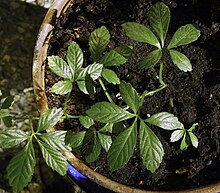Gynostemma
| Gynostemma | |
|---|---|
 | |
| Gynostemma pentaphyllum growing in potting soil | |
| Scientific classification | |
| Kingdom: | Plantae |
| Clade: | Tracheophytes |
| Clade: | Angiosperms |
| Clade: | Eudicots |
| Clade: | Rosids |
| Order: | Cucurbitales |
| Family: | Cucurbitaceae |
| Tribe: | Gomphogyneae |
| Genus: | Gynostemma Blume[1] |
| Species | |
| See text | |
Gynostemma is a genus of perennial climbing vines in the cucumber, gourd, and melon family, comprising at least 19 species, all native to the tropical East or Far East, inclusive of the Himalayas: China (with 9 endemic); the islands of Japan; Malaysia; and New Guinea.[2] The term Gynostemma is derived from Ancient Greek γυνή meaning "woman" or "female",[3] and στέμμα meaning "wreath" or "garland".[3] In (post-)classical Latin the form stemma is attested as Greek loanword.[4][5] In Ancient Greek and Latin, stemma is of neuter gender.[3][4] German-Dutch botanist Carl Ludwig Blume described Gynostemma from two species he named:[6] G. pedata (later changed, to pedatum)[7] and G. simplicifolia (also later changed, to simplicifolium).[8] Neither species was clearly designated by him as the type; however, the former species, G. pedatum is now considered to be a synonym of G. pentaphyllum (Thunb.) Makino.[9] The genus was published in 1825, in Carl Ludwig von Blume's Bijdragen tot de flora van Nederlandsch Indië ("Contributions to the flora of the Dutch East Indies").[1][6]
General description
[edit]All species of Gynostemma have tendrils (usually branching); most are dioecious. The leaves are usually in palmately arrayed leaflets (3–9, ovate-lanceolate in shape), arranged alternately on the stem; a few species are leaved, but without leaflets. Inflorescences are either racemose or paniculate. Fruits can be capsular or pea-like, containing two or three seeds.[2]
Selected species
[edit]- Gynostemma aggregatum C.Y.Wu & S.K.Chen
- Gynostemma burmanicum King ex Chakrav.
- Gynostemma cardiospermum Cogn. ex Oliv.
- Gynostemma caulopterum S.Z.He
- Gynostemma compressum X.X.Chen & D.R.Liang
- Gynostemma guangxiense X.X.Chen & D.H.Qin
- Gynostemma intermedium W.J.de Wilde & Duyfjes
- Gynostemma laxiflorum C.Y.Wu & S.K.Chen
- Gynostemma laxum (Wall.) Cogn.
- Gynostemma longipes C.Y.Wu
- Gynostemma microspermum C.Y.Wu & S.K.Chen
- Gynostemma pallidinervee Z.Zhang
- Gynostemma papuanum W.J.de Wilde & Duyfjes
- Gynostemma pentagynum Z.P.Wang
- Gynostemma pentaphyllum (Thunb.) Makino
- Gynostemma pubescens (Gagnep.) C.Y.Wu
- Gynostemma simplicifolium Blume
- Gynostemma yixingense (Z.P.Wang & Q.Z.Xie) C.Y.Wu & S.K.Chen
- Gynostemma zhejiangense X.J.Xue
- List source :[10]
References
[edit]- ^ a b Gynostemma was originally described and published in Bijdragen tot de flora van Nederlandsch Indië 23. 1825. "Name - !Gynostemma Blume". Tropicos. Saint Louis, Missouri: Missouri Botanical Garden. Retrieved December 1, 2012.
- ^ a b Shukun Chen; Charles Jeffrey. "Gynostemma". Flora of China. 19. eFloras. Retrieved December 1, 2012.
- ^ a b c Liddell, H.G. & Scott, R. (1940). A Greek-English Lexicon. revised and augmented throughout by Sir Henry Stuart Jones. with the assistance of. Roderick McKenzie. Oxford: Clarendon Press.
- ^ a b Lewis, C.T. & Short, C. (1879). A Latin dictionary founded on Andrews' edition of Freund's Latin dictionary. Oxford: Clarendon Press.
- ^ Saalfeld, G.A.E.A. (1884). Tensaurus Italograecus. Ausführliches historisch-kritisches Wörterbuch der Griechischen Lehn- und Fremdwörter im Lateinischen. Wien: Druck und Verlag von Carl Gerold's Sohn, Buchhändler der Kaiserl. Akademie der Wissenschaften.
- ^ a b Original text by Carl Ludwig von Blume (1825). Bijdragen tot de flora van Nederlandsch Indië. p. 23. Retrieved December 1, 2012.
- ^ "Name - Gynostemma pedatum Blume". Tropicos. Retrieved December 1, 2012.
- ^ "Name - !Gynostemma simplicifolium Blume". Tropicos. Retrieved December 1, 2012.
- ^ "TPL, treatment of Gynostemma pedatum". The Plant List; Version 1. (published on the internet). Royal Botanic Gardens, Kew and Missouri Botanical Garden. 2010. Retrieved December 1, 2012.
- ^ "TPL, treatment of Gynostemma". Retrieved December 1, 2012.


 French
French Deutsch
Deutsch